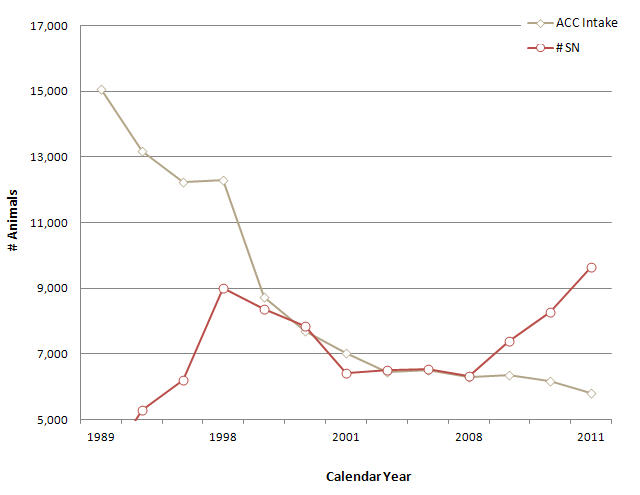How would any of our newly elected politicians answer the question, "What would you do for the lives and welfare of companion animals?"
I doubt that any of them would argue for the status quo -- not if there were suddenly a national focus on the millions of animals abandoned every year, mostly for preventable reasons, and put to death or re-homed at great emotional and financial expense.
Someday that national focus will come, and we can hasten the day. The key is to figure out why animals keep flowing in and how to encourage communities to take responsibility for those lives.
Yes, there have been gains in the percentage of happy outcomes for cats and dogs at animal shelters. The numbers of dogs and cats euthanized has fallen to four million a year -- 40 years ago, it was 20 million. The decrease is probably due to several things; one of the biggest may be the tremendous effort that shelters and rescue groups have put into promoting and adopting homeless animals. Still, cat and dog adoptions from a shelter grab only 20 to 30 percent of the demand for companion animals. It's success of a sort, but nowhere near a real solution.
Most publicly funded shelters are still dumping grounds for poor decisions and ignorance, rather than what a shelter should be: a safe haven for animals that are lost, sick or injured, that are victims of neglect or abuse, or that need new homes when an owner/guardian has experienced a catastrophic life change and can't keep their pet. The statistics most commonly used to measure success in sheltering focus on the outcome, but we need to look at the front door: how do we shift our culture toward personal responsibility, leaving shelters to truly shelter?
The age-old practice of foot binding in China was essentially eliminated in a generation. Moral suasion moves rapidly when the time is right. What if we could convince pet owners it was wrong to abandon their pets to a likely death (at community expense) for reasons like "I'm moving," or "He digs up the yard," or "She had another litter of kittens?"
Spay/neuter programs are the most important step so far toward decreasing intake, which means decreasing euthanasia. Look at San Francisco: According to the SF ACC, 20 years ago, about 13,000 cats and dogs entered the shelter system every year, and over 7,000 of those died. Before high-volume spay/neuter came into being, it was commonplace to kill all the females and adopt out only the males as a crude way to attempt population control. But with the advent of high-volume, high-quality sterilization efforts, look what happened:
San Francisco today has an extremely low intake per capita, so we can spend more time finding the right homes for animals that do come in.
When intake declines, staff can focus on housing animals, keeping them healthy and promoting adoption and transfer to rescues. Having a population you can manage and care for is critical to getting them out alive. Why then are shelters reluctant to ask owners to make an appointment to surrender an animal? That modest step, making people wait until a shelter has room to care for the pet they want to give up, respects the shelter's top priority of being there for the lost and injured. Ideally, we'd maintain a manageable shelter population by limiting the reasons why someone can surrender a pet. But even short of saying no, it doesn't mean shelters have to bend to the whims of irresponsible pet owners.
No other profession is expected to run above capacity on a routine basis -- something that's unhealthy for the staff and even more so for the animals.
Some fear that if owners can't drop off their pet on demand that they will do something horrible to the animal, or simply let it go. Some people may do that, but it fails as a reason to force shelters to take in more animals than they can care for in a cycle of taxpayer-supported suffering.
Our shelter is among those that have resolved not to settle for managing the problem. In fact, we'd like to put ourselves out of business. Our philosophy at the SF SPCA is that once an animal makes it into a shelter, we've already failed in our mission. This year we drew up a roadmap to end animal abandonment here by 2020, relying on three tenets: prevention, education and rescue. Every one of our programs and services touches on at least one. We've identified the three main reasons animals end up in shelters -- overpopulation, barriers to veterinary care and behavioral issues -- and we try to address these aggressively.
The programs aren't new, but we hope that refining our priorities will stimulate a synergy that will get us to our goal. Until animal abandonment is eradicated, we can't stop. We won't stop.
With all the electioneering over, one thing we can agree on is that we should keep advancing our expectations. Who is digging down to the root of social problems like animal abandonment? We need leaders who understand the cascade effect of every decision. Who say: can't stop. Won't stop.
